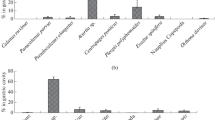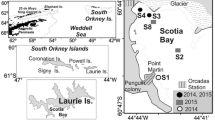Abstract
The ecological importance of appendicularians Oikopleura dioica and O. longicauda, and a doliolid Dolioletta gegenbauri as metazoan secondary producers was assessed in summer 1997 in the Seto Inland Sea, Japan. Blooms by the appendicularians occurred twice within a month following peaks of pico-/nanoplankton biomass. The biomass of Oikopleura spp. averaged over the water column (<B> ranged 0.1 to 8.0 μgC l-1 and temporal average of <B> over the survey period (\( < \bar B > \)) was 3.2 μgC l-1, 70% of \( < \bar B > \) for calanoid copepods. Furthermore, the temporal average of the production for Oikopleura spp. was 2.4 times higher than that for calanoids, reflecting the extraordinary high growth rates of the appendicularians. D. gegenbauri developed its population following a diatom bloom and <B> reached to 37 μgC l-1 at the peak time. Although individuals of D. gegenbauri were seldom observed during the first half of the survey, \( < \bar B > \) for the doliolid (8.4 μgC l-1) nearly doubled that for calanoids. These results indicate that the gelatinous tunicates Oikopleura spp. and D. gegenbauri play important roles as metazoan secondary producers in the Seto Inland Sea during summer.
Similar content being viewed by others
References
Alldredge, A.L., 1976. Field behaviour and adaptive strategies of appendicularians (Chordata; Tunicata). Mar. Biol. 38: 29–39.
Alldredge, A.L., 1981. The impact of appendicularian grazing on natural food concentrations in situ. Limnol. Oceanogr. 26: 247- 257.
Alldredge, A.L. & L.P. Madin, 1982. Pelagic tunicates: unique herbivores in the marine plankton. BioScience 32: 655–663.
Crocker, K.M., A.L. Alldredge & D.K. Steinberg, 1991. Feeding rates of the doliolid, Dolioletta gegenbauri, on diatoms and bacteria. J. Plankton Res. 13: 77–82.
Deibel, D., 1982a. Laboratory determined mortality, fecundity and growth rates of Thalia democratica Forskal and Dolioletta gegenbauri Uljanin (Tunicata,Thaliacea). J. Plankton Res. 4: 143–153.
Deibel, D., 1982b. Laboratory-measured grazing and ingestion rates of the salp, Thalia democratica Forskal, and the doliolid, Dolioletta gegenbauri Uljanin (Tunicata, Thaliacea). J. Plankton Res. 4: 189–201.
Deibel, D., 1985. Blooms of the pelagic tunicate, Dolioletta gegenbauri: are they associated with Gulf Stream frontal eddies? J. Mar. Res. 43: 211–236.
Flood, P.R., 1978. Filter characteristics of appendicularian food catching nets. Experientia 34: 173–175.
Hirota, R., 1979. Seasonal occurrence of zooplankton at a definite station off Mukaishima from July of 1976 to June of 1977. Publ. Amakusa Mar. Biol. Lab. 5: 9–17.
Hopcroft, R.R. & J.C. Roff, 1995. Zooplankton growth rates: extraordinary production by the larvacean Oikopleura dioica in tropical waters. J. Plankton Res. 17: 205–220.
Hopcroft, R.R. & J.C. Roff, 1998. Production of tropical larvaceans in Kingston Harbour, Jamaica: are we ignoring an important secondary producer? J. Plankton Res. 20: 557–569.
Hopcroft, R.R., J.C. Roff & H.A. Bauman, 1998. Zooplankton growth rates: the larvaceans Appendicularia, Fritillaria and Oikopleura in tropical waters. J. Plankton Res. 20: 539–555
King, K.R., J.T. Hollibaugh & F. Azam, 1980. Predator-prey interactions between the larvacean Oikopleura dioica and bacterioplankton in enclosed water columns. Mar. Biol. 56: 49–57.
Koshikawa, H., S. Harada, M. Watanabe, K. Sato & K. Akehata, 1996. Relative contribution of bacterial and photosynthetic production to metazooplankton as carbon sources. J. Plankton Res. 18: 2269–2281.
Madin, L.P., J.E. Purcell & C.B. Miller, 1997. Abundance and grazing effects of Cyclosalpa bakeri in the subarctic Pacific. Mar. Ecol. Prog. Ser. 157: 175–183.
Nakamura, Y., 1998. Biomass, grazing and production of a large heterotrophic dinoflagellate Noctiluca scintillans. J. Plankton Res. 20: 2213–2222.
Nakamura, Y., S. Sasaki, J. Hiromi & K. Fukami, 1993. Dynamics of picocyanobacteria in the Seto Inland Sea (Japan) during summer. Mar. Ecol.Prog. Ser. 96: 117–124.
Nakamura, Y., S. Suzuki & J. Hiromi, 1995. Population dynamics of heterotrophic dinoflagellates during a Gymnodinium mikimotoi red tide in the Seto Inland Sea. Mar. Ecol. Prog. Ser. 125: 269- 277.
Nakamura, Y., S. Suzuki & J. Hiromi, 1996. Development and collapse of a Gymnodinium mikimotoi red tide in the Seto Inland Sea. Aquat. Microb. Ecol. 10: 131–137.
Nakamura, Y., K. Suzuki, S. Suzuki & J. Hiromi, 1997. Production of Oikopleura dioica (Appendicularia) following a picoplankton’ bloom’ in a eutrophic coastal area. J. Plankton Res. 19: 113- 124.
Paffenhöfer, G.-A., 1976. On the biology of Appendicularia of the southeastern North Sea. In Persoone, G. & E. Jaspers (eds), 10th European Symposium on Marine Biology. Universa Press, Wetteren, Belgium: 437–455.
Shanks, A. & K. Walters, 1996. Feeding by a heterotrophic dinoflagellate (Noctiluca scintillans) in marine snow. Limnol. Oceanogr. 41: 177–181.
Uonani, I., A. Izuha & K. Asai, 1978. Food habits and selective feeding of anchovy larvae (Engraulis japonica). Bull. Jap. Soc. Sci. Fish. 44: 427–434 (in Japanese with English abstract).
Uye, S., 1982. Length-weight relationships of important zooplankton from the Inland Sea of Japan. J. Oceanogr. Soc. Japan 38: 149–158.
Uye. S., 1991. Temperature-dependent development and growth of the planktonic copepod Paracalanus sp. in the laboratory. Bull. Plankton Soc. Japan (Special volume): 627–636.
Uye, S. & S. Ichino, 1995. Seasonal variations in abundance, size composition, biomass and production rate of Oikopleura dioica (Fol) (Tunicata: Appendicularia) in a temperate eutrophic inlet. J. Exp. Mar. Biol. Ecol. 189: 1–11.
Uye, S. & A. Murase, 1997. Relationship of egg production rates of the planktonic copepod Calanus sinicus to phytoplankton availability in the Inland Sea of Japan. Plankton Biol. Ecol. 44: 3–11.
Uye, S. & T. Shimazu, 1997. Geographical and seasonal variations in abundance, biomass and estimated production rates of mesoand macrozooplankton in the Inland Sea of Japan. J. Oceanogr. 53: 529–538.
Watson, S.W., T.J. Novitsky, H.L. Quinby & F.W. Valois, 1977. Determination of bacterial number and biomass in the marine environment. Appl. Environ. Microbiol 33: 940–946.
Author information
Authors and Affiliations
Rights and permissions
About this article
Cite this article
Nakamura, Y. Blooms of tunicates Oikopleura spp. and Dolioletta gegenbauri in the Seto Inland Sea, Japan, during summer. Hydrobiologia 385, 183–192 (1998). https://doi.org/10.1023/A:1003531812536
Issue Date:
DOI: https://doi.org/10.1023/A:1003531812536




